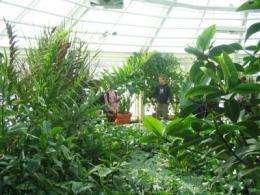Researchers say children need horticultural interventions

Could "interventions" bring children closer to nature? Researchers in Finland think so. A new study published in HortTechnology compares urban and rural children's relationships with plants and recommends horticultural interventions, especially for urban children.
In Finland, a country famous for its forests and wilderness, researchers Taina Laaksoharju from the Department of Agricultural Sciences at the University of Helsinki and Erja Rappe of The Martha Association teamed up to investigate the role of vegetation in the lives of urban and rural children. "We were interested in finding out if it is true that children are not interested in plants or playing outdoors", they noted.
The study examined the relationships of 9- and 10-year-old Finnish school children to the environment and plants. Using a questionnaire of structured and open-ended questions, the researchers focused on two comparisons: children's relationships with nature in rural and urban neighborhoods, and preferences for plants among boys and girls. 76 children—42 in the Helsinki suburb area and 34 in a rural area—participated in the study.
Results suggested that children living in rural surroundings had closer contact with nature than their urban counterparts. For example, more rural children considered people to be "part of nature" than did urban children. The researchers noted that, like children in other Western countries, Finnish children may be in danger of losing direct contact with the natural environment. "This suggests that further research is essential to understand children's experiences if we are to enhance the crucial role of the environment in their lives", they wrote.
The children's answers indicated that natural areas are important arenas for children's free play and socializing. "In the suburbs, closer connections to nature are rare; interventions in schools, especially outdoor horticultural ones, can help children to build their relationship to vegetation." The research also showed significant differences in the ways boys and girl experience green plants. Girls were more interested in plants in general, and were more eager to learn about plants than were the boys. Boys saw themselves as more independent of nature; more than 30% of the boys said that they could live without vegetation. Boys wrote that plants are meaningful mainly for nutrition and general living conditions, whereas girls appreciated the beauty of flowers and plants.
Laaksoharju and Rappe included recommendations for delivery of horticultural lessons based on remarks from the 9- and 10-year-old boys, who said that they did not like lectures, but enjoyed working with plants. "Learning by doing in an informal learning environment suits the kinesthetic boys better than sitting at a desk listening to a teacher", they said. "Horticultural interventions can be effective starting points to add to children's knowledge, affection, and interest toward greenery, but it is highly recommended that they take place outdoors rather than indoors."
More information: horttech.ashspublications.org/ … nt/abstract/20/4/689
Provided by American Society for Horticultural Science















